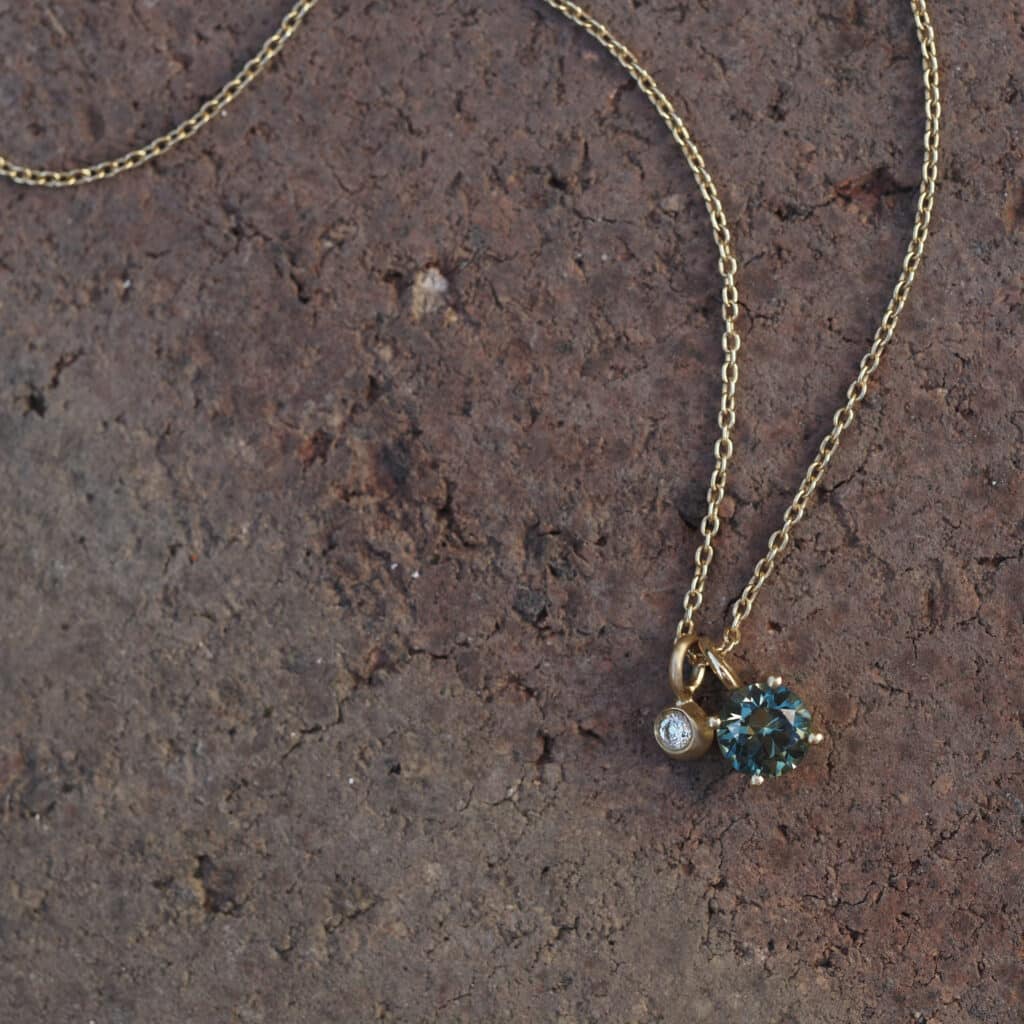My passion for Australian gemstones is partially from my curiosity for origin stories. I’ve always been interested in learning where something comes from and how its experience shapes it into what it is today. Over the years, I’ve been asked to source birthstones to represent family members and loved ones in heirloom jewellery. Given my preference for Australian gemstones, I’ve set myself the task of creating a (brief) guide to Australian-sourced birthstones.
The history of birthstones is as fascinating as it is ambiguous. The custom of wearing a single birthstone to represent a month of the year is only a few centuries old, and historians offer different lore and legends. The tradition has been traced to eighteenth-century Poland, Germany in the 1560s, the Hebrew Bible, a 5th-century Hindu text, and so on. There are also variations of the stones that belong to each month of the year. The selection of Australian birthstones I’m using is a blend of modern and traditional birthstones as defined by the International Gem Society. I chose them because of the ability to source them locally here in Australia (where some are easier to find than others!).
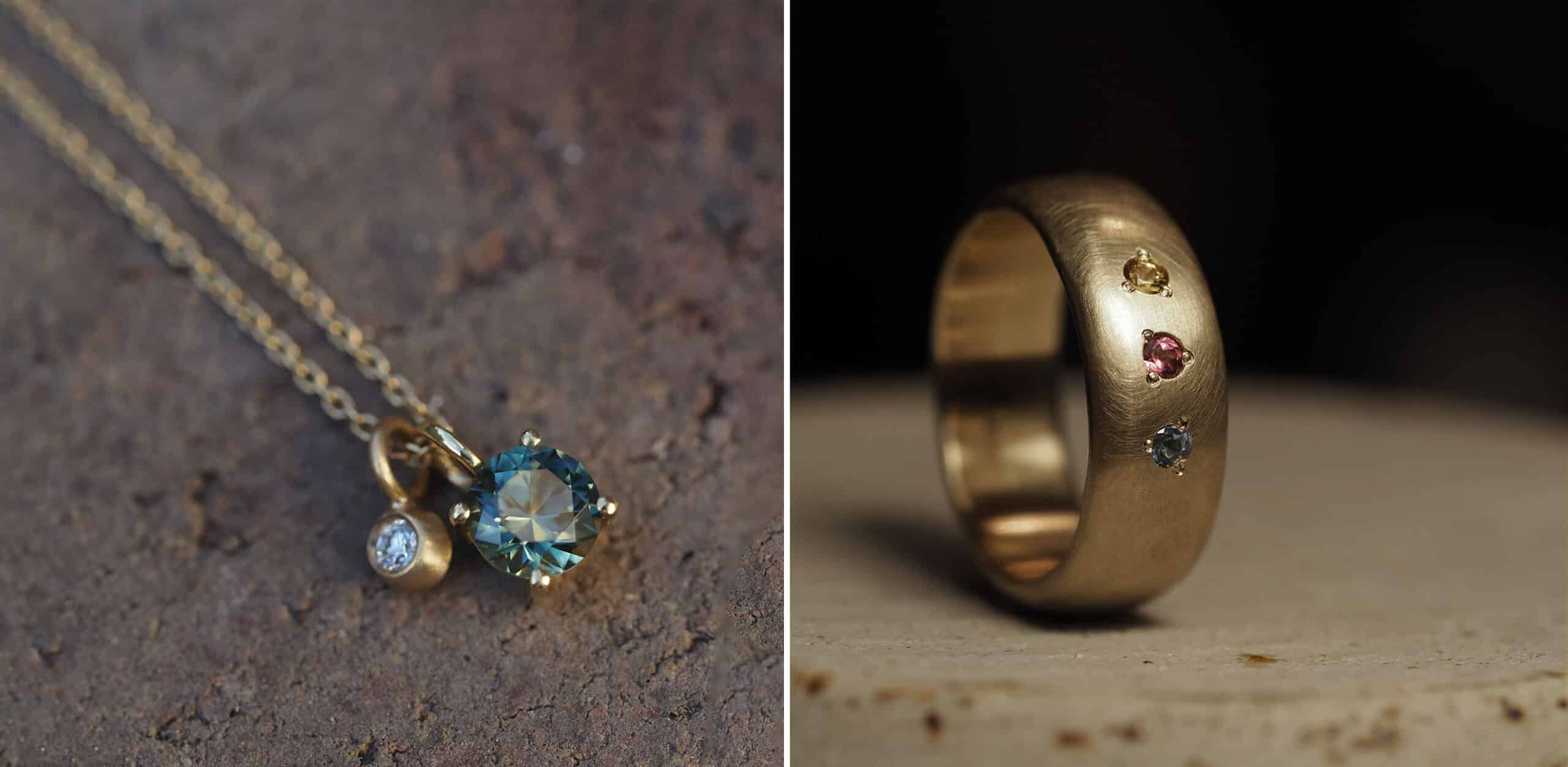
(Left) A custom 18ct yellow gold necklace with an Argyle diamond and Australian sapphire. (Right) A custom ring, set with Aquamarine, Garnet and Sapphire—the birthstones of a client’s children.
JANUARY – Red Garnet
The first month of the calendar year is a red garnet (though not all garnets are red).
A German theologian, Albrecht von Bollstadt (1193-1280), coined the name, from the Latin ‘granatus’ (‘seeds’) in reference to the bright red seeds of a pomegranate.
Australia produces half of the world’s mineral garnets, with the majority unearthed in Port Gregory, Western Australia. Gem-quality stones are also found across the Harts Ranges near Alice Springs, Broken Hill, Bathurst and Orange in New South Wales and Queensland’s aptly named Mount Garnet.
FEBRUARY – Amethyst
Australian amethyst is a popular purple variety of quartz that often bears a beautiful gradient of colour, from clear or smoky quartz to bright purple. Gem-grade Amethyst has been found at various sites, from the Ashburton River in Western Australia to Hart’s Range and Wave Hill station in the NT, Cloncurry area in Qld and Broken Hill, NSW and Beechworth in Victoria.
MARCH – Aquamarine
A genuinely brilliant stone, aquamarine is the blue variety of the mineral Beryl. Its name comes from the Latin word for ‘seawater’. It’s a rare gemstone in Australia, though small amounts have been found near Mount Surprise in Queensland, Nardoo Hill, Western Australia and Torrington in NSW. A cutter I work closely with has also personally found gem-grade aquamarine from the Norseman area and seen stones from the Giles Prospect and Gascoyne regions of WA.
APRIL – Diamond
No doubt the most ubiquitous gemstone, the Australian varieties of diamond are exceptional. Australian Argyle white diamonds feature heavily in my work, alongside cognac and champagne-coloured Australian diamonds, which I love for their understated elegance. Most of these come from the legendary mines in the Kimberley region of Western Australia. However, some have been found sporadically in the Northern Territory and even NSW, SA and VIC.
MAY – Emerald
Bright and cartoon green, the Australian Emerald has been commercially mined in four primary deposits: Wonder Well (Menzies), Poona (Cue) and Curlew (Pilbara) in Western Australia and Emmaville (Torrington) in New South Wales. The Torrington emeralds are particularly rare and spectacular and often bear a striking colour banding created by the occurrence of chromium.
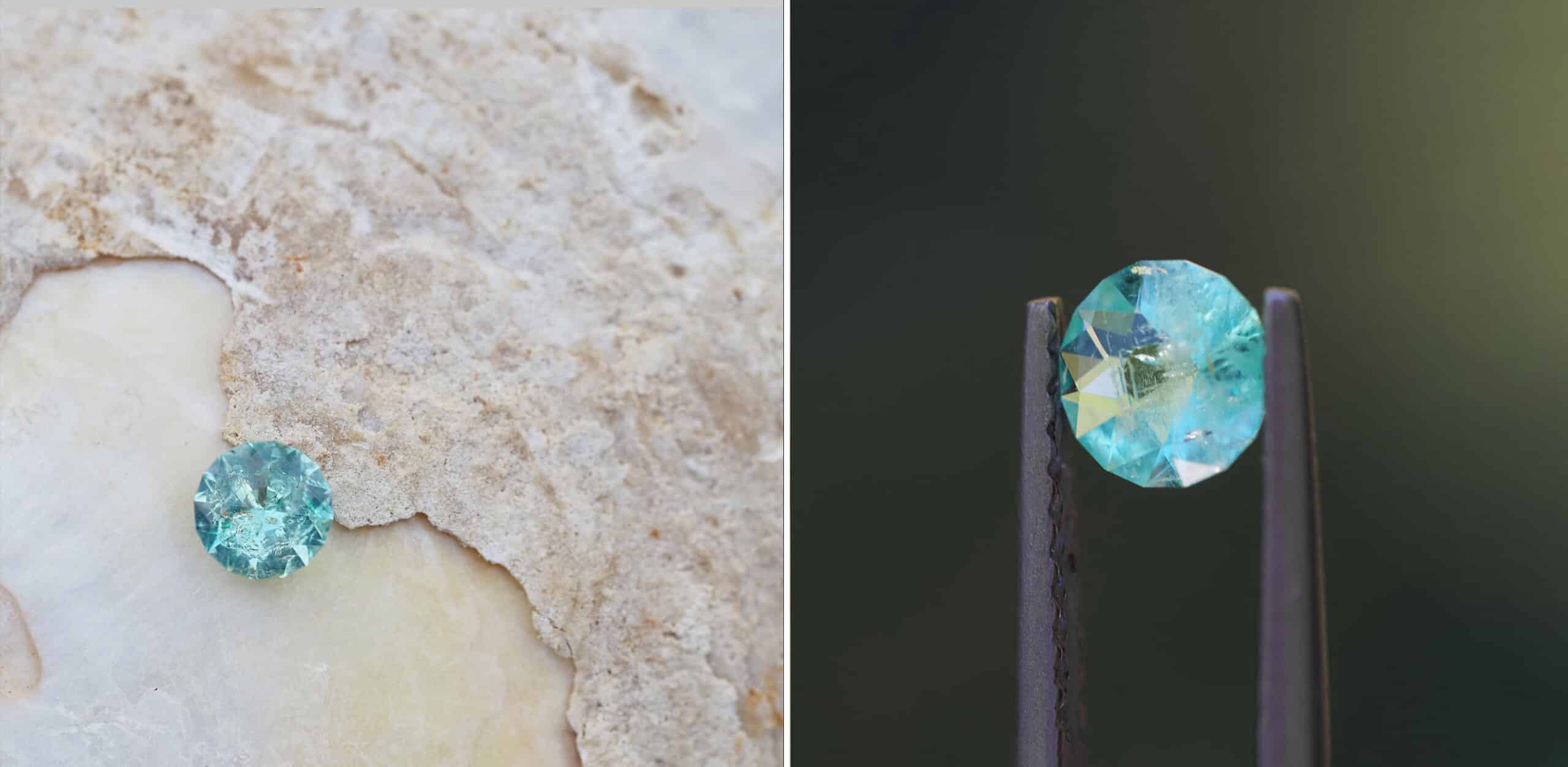
(Left) Australian Emerald from Torrington, New South Wales. (Right) Australian Emerald from Poona, Western Australia.
JUNE – Pearl
The formation of pearls is a profoundly fascinating process. It’s formed in one of two ways: a pearl is formed either when an irritant naturally makes its way or is “planted” inside an oyster or mollusc shell and activates its defence system. Over two years, it coats a spherical nucleus with a substance called ‘nacre’, producing a lustrous and precious pearl.
Australia produces some of the rarest and most prized pearls in the world, like the White Cygnet Bay Pearls from the Kimberley Coast of Western Australia, known for their lush and velvety sheen.
JULY – Ruby
Australian red rubies, rare and radiant, are usually found in metamorphic rocks, such as those in the gem-rich region of Harts Range in the Northern Territory. It has also been found at various sites in New South Wales, including the Macquarie and Cudgegong Rivers, Tumbarumba and the New England region.
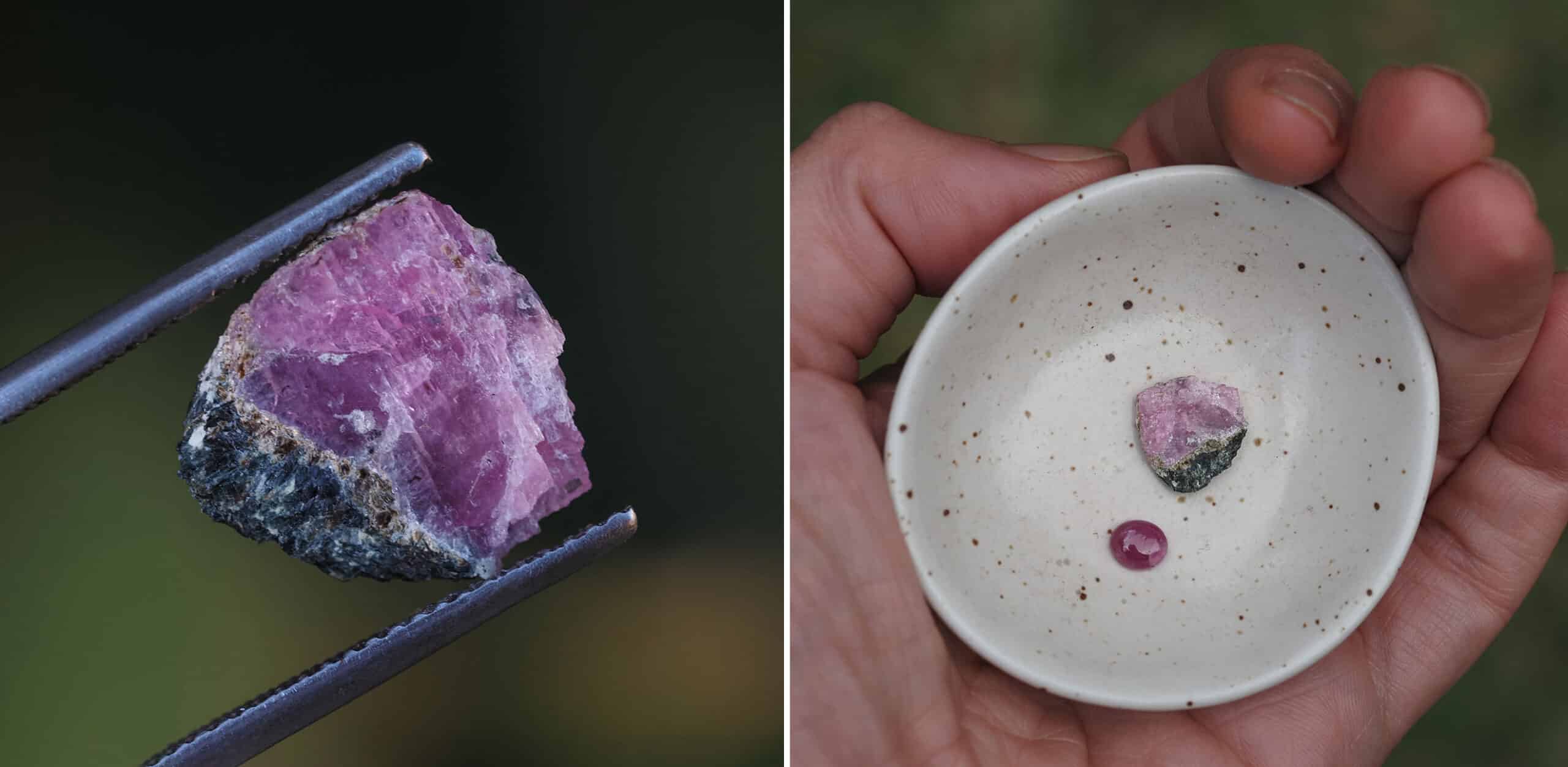
Australian Ruby from Harts Range in the Northern Territory.
AUGUST – Peridot
Peridot is the name given to gem-quality olivine; as the name suggests, this gemstone is a lovely shade of olive green. Australian peridots are rare and only come from several small deposits amongst landscapes with a history of basalt flows in Queensland, Victoria and Tasmania.
SEPTEMBER – Sapphire
An Australian sapphire can come in a range of colours across the spectrum, from the well-known royal blue to pastel sky blueand shades of pink, green, yellow and orange. Parti sapphires, also known as polychrome sapphires, show more than one colour in a single stone with a transparent partition between the colours, hence the name Parti.
In New South Wales, sapphires and rubies are mined in the New England region, around Inverell and Glen Innes, and north-west of Goulburn, near Oberon. They’re also fossicked along the edges of old riverbeds in Northeastern Tasmania and found in abundance around Sapphire and Rubyvale in Queensland.
Australian sapphires are one of my favourite gemstones to work with. Their ethereal beauty and unexpected colourways will always have a place on my bench and in my heart.
OCTOBER – Opal
Is there any stone as iconically Australian as the opal? From the incredible underground mines of Coober Pedy and Andamooka in South Australia to the elusive and effervescent black opals of Lightning Ridge in NSW and the milky gems of White Cliffs, we are so lucky to have access to an abundance of this diverse and mesmerising gem.
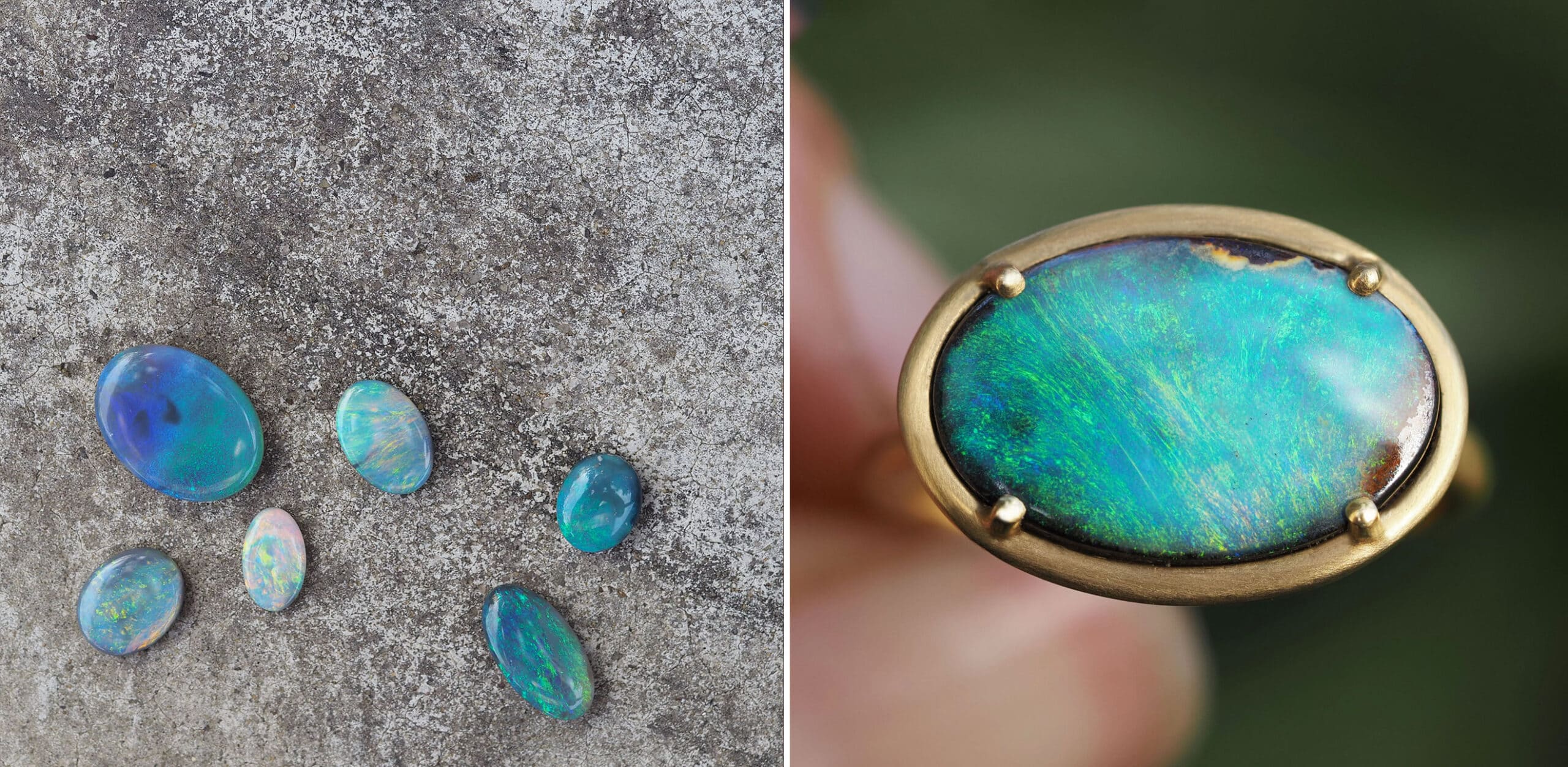
(Left) Australian black opals from Lightning Ridge in NSW. (Right) The Ocean Opal Ring featuring an Australian boulder opal from Queensland in 18ct yellow gold.
NOVEMBER – Topaz
Australian topaz comes in various colours, the most common being clear, pale yellow and pale blue.
Gem-quality topaz has been found widely across Australia, from the New England area of New South Wales across to Lightning Ridge, in Queensland near Mount Surprise and Mount Garnet, around Beechworth in Victoria and the Coolgardie and Menzies region of Western Australia. An exceptional and brilliant white type of “Tasmanian Topaz” is found only on Flinders Island and is known locally as “Killiecrankie Diamond.” After the source location of Killiecrankie, other Tasmanian sources of Topaz are found in the same sapphire-bearing river gravels around the North Eastern region of the Island.
DECEMBER – Turquoise
I am really fascinated with Australian Turquoise. I’ve been using it more and more in my work lately, and I’ve written about what makes Australian Turquoise stones so special in the past.
Australian turquoise has a distinctive and unusual appearance. To me, each turquoise stone appears to hold its own little world. I classify them with different names: “water” stones, the solid blue stones with slightly mottled patterns throughout; “coast” stones, the stones with the coffee-coloured host rock or spider web veins; and “sky” stones, the rarer stones that are a flat colour with little to no inclusions.
Australian-sourced Turquoise is incredibly rare. The rough I source was mined in the Northern Territory during the 1970s. Today, no more Turquoise is mined in Australia, making the Turquoise I work with extra precious.
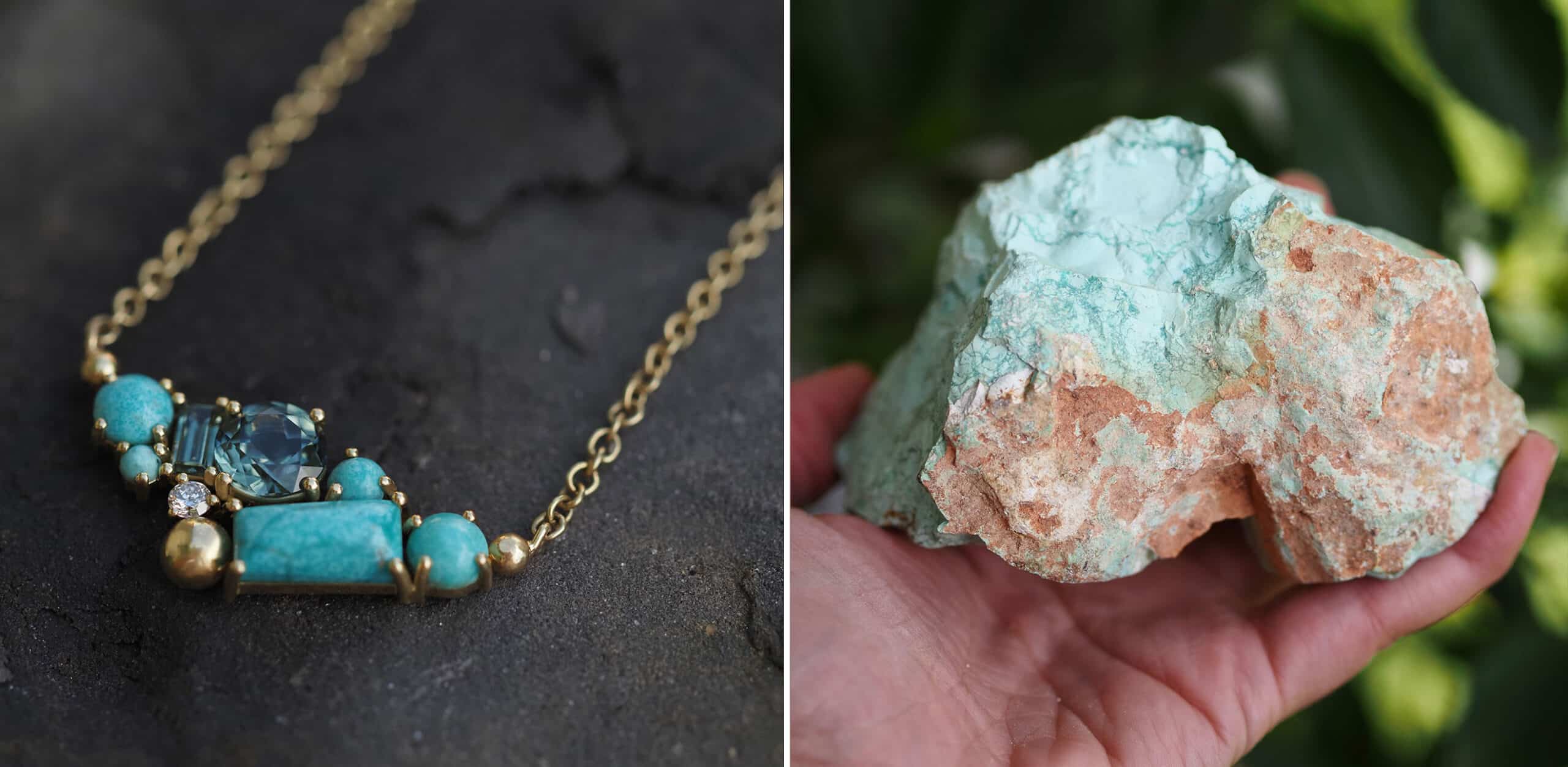
(Left) The Seagrass Meadow Necklace featuring Australian turquoise from the Northern Territory, Australian sapphires from Queensland and an Australian Argyle diamond from Western Australia. (Right) Australian turquoise specimen from The Northern Territory.
